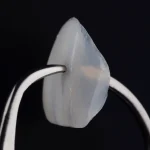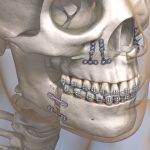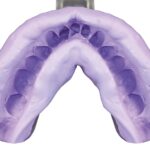
The placement of osseointegrated dental implants has become a common and routine procedure in clinical dental practice today. (1)
Implant therapy must be oriented towards the prosthetic rehabilitation of the patient with the ultimate goal of functional and aesthetic restoration.
Today, single or multiple edentulism can be treated with an implant-prosthetic approach, avoiding the need to resort to traditional fixed prostheses which would inevitably be more invasive on the abutment dental elements of the prostheses themselves. (2)
An implant-prosthetic rehabilitation must include a suitable positioning of the implants within the bone component with specific positional and angular characteristics in order to facilitate the subsequent prosthetic rehabilitation itself.
Benefits and difficulties of correct prosthetic positioning
Correct prosthetic positioning of the implants has many advantages, including:(3)
- Better aesthetic results;
- Improved prosthetic results;
- Enhanced long-term stability of the peri-implant soft and hard tissues due to simpler oral hygiene manoeuvres;
- Better occlusal relationships;
- Improved occlusal loads;
- The possibility of creating screwed and non-cemented prosthetic superstructures.
All these factors contribute to the better long-term success of implant-prosthetic therapies.
Prosthetically guided placement of implants can be made difficult by the presence of any anatomical and surgical limitations. (1)
These anatomical limitations, as well as the exact volume and quality of the bone, can now be assessed early in the diagnostic phase through modern 3D radiographic examinations (CT, CBCT). (1)
Study and 3D planning of the implant-prosthetic case now make it possible to consider all these factors, as well as calculate and plan the correct distances between implants and between implant and tooth. (3)
Since the 1990s, implant design software, which can be used to plan the three-dimensional positioning of implants within the bone, has become increasingly popular. (3)
The concept of guided surgery enables the transfer of implant planning from diagnostic records into clinical reality, in the patient’s mouth.
Two types of guided surgery are described in the literature: static and dynamic. (3)
Static guided surgery
The static approach to guided surgery refers to the use of a static surgical template.
Using the template, the implants can be placed in the position planned in the software without the option of making intra-operative changes. (4)
The template can be manufactured using CAD-CAM techniques (5) or with liquid resins on a stereolithographic model. (6)
To obtain information on the anatomy of the soft tissues, data can be combined from an intraoral scan or a traditional impression scan with 3D data from a CBCT or CT scan through digital alignment of these records.
The alignment is possible thanks to the presence of common reference points in both records, i.e. dental elements. (3)
The guides are then created using CAD-CAM milling or 3D printing procedures.
Guide supports
The guides can have different supports:
- Dental support: the templates are placed on the remaining teeth;
- Mucosal support: the templates are placed on the mucosal surface. This approach is used in completely edentulous patients;
- Bone support: after a flap is opened, the templates are positioned in direct contact with the bone;
- Special support: through mini-implants or pins, the guides are welded to the bone bases before the actual insertion of the implants.
According to a systematic review of the literature (7), bone-supported templates would offer the worst level of accuracy.
Then there are other, more or less “guided” systems.
Some protocols (fully guided) require that each stage of site preparation and implant placement be guided by the template, while others require the final implant placement to be done freehand.
Fully guided systems appear to ensure more accurate implant placement. (7)
For its ease of use and lower investment costs, static guided surgery has established itself as the technique of choice compared to dynamic surgery. (6)
Dynamic guided surgery
The first dynamic guided surgery systems date back to 2000.
The dynamic approach, also called navigation, refers to the use of an implant navigation system that reproduces the virtual position of the implant in real time within the computed tomographic data and allows inter-operator changes in position. (4,7)
All these systems are based on the real-time detection of the three-dimensional position of the implant handpiece and, consequently, on the position of the implant preparation drills and of the implant.
Dynamical systems have always been too expensive and complex for simple private use, and for this reason, the first generations of these technologies slowly disappeared from the market. (3)
Thanks to what is called the fourth industrial revolution, however, these systems could become of clinical interest again. The divide between the physical and digital worlds is becoming increasingly narrow, and processes could be further simplified. (3)
With this type of approach, without a static physical template, the therapeutic process could be simplified and the procedure further speeded upwhile maintaining the advantages of a surgically guided approach.
Conclusions
In conclusion, both techniques allow a prosthetically guided approach to implantology with all the advantages described above.
Furthermore, knowing in advance where the implant will emerge, these techniques could be interesting in the future in immediate loading implant procedures.
Guided surgery also enables a more targeted flapless approach, with its advantages and disadvantages, in total safety.
To date, based on the available scientific literature (3), it cannot be concluded that guided implant surgery is superior in terms of safety, results or efficacy compared to freehand surgery.
Various errors may accumulate during the various phases of the procedures, resulting in a certain degree of clinical inaccuracy.
The continuous development of technologies, the refinement of techniques and the reduction of initial investment costs make guided implant surgery a very promising technique.
References
- Dioguardi, M., Spirito, F., Quarta, C., Sovereto, D., Basile, E., Ballini, A., … & Mastrangelo, F. (2023). Guided dental implant surgery: systematic review. Journal of Clinical Medicine, 12(4), 1490.
- Scheuber, S., Hicklin, S., & Brägger, U. (2012). Implants versus short‐span fixed bridges: survival, complications, patients’ benefits. A systematic review on economic aspects. Clinical oral implants research, 23, 50-62.
- D’haese, J., Ackhurst, J., Wismeijer, D., De Bruyn, H., & Tahmaseb, A. (2017). Current state of the art of computer‐guided implant surgery. Periodontology 2000, 73(1), 121-133.
- Jung R, Schneider D, Ganeles J, Wismeijer D, Zwahlen M, Hammerle CH, Tahmaseb A. Computer technology applications in surgical implant dentistry: a systematic review. Int J Oral Maxillofac Implants 2009: 24: 92–109.
- Buser D, Halbritter S, Hart C, Bornstein MM, Grutter L, Chappuis V, Belser UC. Early implant placement with simultaneous guided bone regeneration following single tooth extraction in the esthetic zone: 12-month results of a prospective study with 20 consecutive patients. J Periodontol 2009: 80: 152–162
- Buser D, Wittneben J, Bornstein MM, Grutter L, Chappuis V, Belser UC. Stability of contour augmentation and esthetic outcomes of implant-supported single crowns in the esthetic zone: 3-year results of a prospective study with early implant placement post extraction. J Periodontol 2011: 82: 342–349.
- Tahmaseb A, Wismeijer D, Coucke W, Derksen W. Computer technology applications in surgical implant dentistry: a systematic review. Int J Oral Maxillofac Implants 2014: 29: 25–42.
Would you like more information about Zhermack Dental products and solutions?
Contact us




 Zhermack SpA has been one of the most important producers and international distributors of alginates, gypsums and silicone compounds for the dental sector for over 40 years. It has also developed solutions for the industrial and wellbeing sectors.
Zhermack SpA - Via Bovazecchino, 100 - 45021 Badia Polesine (RO), Italy.
Zhermack SpA has been one of the most important producers and international distributors of alginates, gypsums and silicone compounds for the dental sector for over 40 years. It has also developed solutions for the industrial and wellbeing sectors.
Zhermack SpA - Via Bovazecchino, 100 - 45021 Badia Polesine (RO), Italy.


